Tag archives for: American Institute of Architects

Firms Report Strongest Billing Since Before Recession
PHILADELPHIA (MNI) – U.S. architects are enjoying the fastest growth in billings since before the recession for their work on a range of residential and commercial construction projects, and expect continued growth in coming months, according to company owners and a trade association.
Architecture firms in Los Angeles, New York, and Charlotte, North Carolina said they have hired more people in recent months and expect to hire again to cope with the extra demand from developers of apartment buildings, retail space and in some cases institutional properties like charter schools.
While some companies have at least doubled their billing and the size of their payrolls since the depths of the recession, most said they have work in the pipeline that suggests even stronger revenue in 2015.
“This is really just getting underway,” said Kermit Baker, chief economist at the American Association of Architects, in an interview. “We are very much in the early innings of what looks to be a healthy recovery.”
The AIA’s monthly index of billing, which in July showed its strongest growth since mid-2007, is expected to show continued strength when the August index is released on Sept. 24, Baker said.
“I don’t think there’s any evidence that August was off that trend line significantly,” he said.
The industry has seen intermittent growth during the last three or four years so the evidence of a sustained upturn is not yet conclusive but the current increase is the strongest since the recession, Baker said.
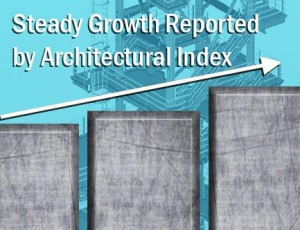
The growth suggests there will be an upturn in non-residential construction spending of around 10% in 2015, Baker said. He attributes the upswing to improving business confidence and better access to capital.
“Businesses are finally at a stage where they are comfortable reinvesting in their facilities, and comfortable that the economic upturn is going to be sustained,” he said. “They are seeing sufficient demand to justify reinvestment.”
The greater availability of financing is allowing the restart of construction projects that stalled several years ago because of a tight credit environment after the recession.
“Financing has begun to ease up a little bit,” Baker said. “Surprisingly strong numbers of firms are saying they are now working on projects that they had begun three or four years ago, but stopped work and now they have come back.”
Even the market for design of institutions such as schools is coming back after a period when it was hurt by a decline in local government tax revenue.
“The last couple of months we have seen very strong numbers on the institutional side, which would suggest that construction activity moving into 2015 will begin to pick up,” Baker said.
The higher demand for institutional work has been seen in New York City where Caples Jefferson Architects is designing schools for both public and private-sector clients, as well as undertaking more work on residential projects.
“There are lots and lots of charter school construction going on right now as well as public construction,” said Sara Caples, president and principal of the firm in Long Island City.
Caples said demand for her firm’s services is at its strongest for at least five years, and that billing in the last few months has been about double its level of a year earlier. And in a sign that billings will growth further, she said she has had a “flood” of requests for proposals in recent months, and is responding to an unusually large number of them.
“We throw out a lot of requests for proposals if we don’t think we have a strong chance, and we’re still putting out a major proposal every week or so, which is just extraordinary,” she said.
Current projects include a 20,000 square-foot charter school in the Bronx, and a 40,000 square-foot charter school plus a 12-unit residential component in Manhattan, she said.
Residential developments are facilitating the construction of associated institutional projects because of the strong retail market in New York, Caples said.
“The market is strong enough that the residential makes it viable to build the six-story school on quite a challenging site,” she said. “The 12 residential units will allow them to pay off the mortgage very rapidly. The residential market seems to be the little engine that’s financing quite a lot of things.”

The eight-person firm already is two architects bigger than it was at the start of 2014, and may add more, despite an extremely selective hiring policy, if it takes on just one or two projects, she said.
The growth is being fueled by easier access to finance, which is helping not only to revive dormant projects but to launch new ones, Caples added.
“That’s what’s different about this,” she said. ‘Now, people are actually making new deals with their financiers that haven’t been kicking around forever.”
And she said her firm’s current growth seems to be representative of the market as a whole. “Most of the people that we talk to seem to be experiencing similar patterns,” she said.
In Charlotte, North Carolina, The Housing Studio, an architecture firm specializing in multi-family housing projects around the East Coast between Philadelphia and Charlotte, and in the Denver, Colorado area, is seeing an “explosion” in growth, said President Chuck Travis.
He said the company is billing about $3 million annually or more than three times the level during the recession. Its 28-strong work force is now about twice its traditional size, and four times its level at the low point of the recession. Travis said he’s looking to hire four or five more architects.
Travis said the growth is unprecedented in the company’s 18-year history. “It’s exponential growth in a two-year time frame,” he said.
He attributed the upswing to increased demand for rental housing in the walkable or transit-oriented urban areas that are favored by the “millennial” workers who eagerly sought by developers across the country.
That sector of the population is less interested in housing as an investment than was the previous generation, and prefers the flexibility of rented accommodation, he said, predicting continued growth.
“We’re not showing any signs of slowing down,” he said.
The demand for downtown living is also being seen in a three-square-mile area of Los Angeles, where 6,000 residential units are under construction and another 14,000-16,000 units are being planned, according to Simon Ha, a partner with TSK Architects.
That is creating more work for firms like TSK which is billing 30% more than it did a year ago, and has hired four architects this year for a total of 10, Ha said. And demand is stronger than it was in the pre-recession years of 2006-2007.
The construction boom, which he said is being fueled by investment from China, has resulted in land prices in the downtown area jumping to around $400 a square foot from $250-$300 two years ago. Land near LA’s Staples Center is now selling for about $600 a square foot, or about double its level two years ago, he said.
With a booming population of single people demanding housing in previously desolate urban areas like downtown LA, there are big opportunities for companies like TSK which has increased its billing for residential design to 70% of its total, Ha said.
By JON HURDLE, August 2014.
Search Careers
Request Talent
Join Mailing List

Architecture salaries increase
and the job market is on fire.
Review our current job listings
| Project Architect | Corporate Interiors |
New York |
| Space Planner | University |
New York, New York |
| Assistant Construction PM | Hi-End Residential |
New York, New York |
| Business Development l Project Manager |
Bend, Oregon |
| Senior Interior Designer | Corporate Interiors |
New York, New York |
| Senior Design Architect | Hi-End Residential |
Miami or NY, Florida |
| Senior Technical Architect or Job Captain l Multiple Project Types |
Santa Monica, California |
| Technical and Design Architect | Multiple Projects |
Santa Monica, California |
| Technical Coordinator | Hospitality/Corporate |
New York, New York |
| Senior Interior Designer | Commercial Interiors |
New York |
| Project Manager | Commercial Interiors |
New York, New York |
| Intermediate/Senior Project Manager | Corporate Interiors |
New York, New York |
| Principal Technical Architect | Commercial Interiors |
New York City, New York |
| Intermediate Interior Designer l Multi-Family Residential |
Los Angeles, California |
| Construction Cost Estimator | Mixed-Use. Commercial, Residential |
Los Angeles, California |
| Project Manager | Multi-Family Housing |
New York, New York |
| Intermediate Architectural Lighting Designer |
New York, New York |
| Project Architect | Global Commercial/Global Retail |
Santa Monica, California |
| Intermediate Project Architect | Retail or Hospitality |
New York, New York |
| Project Architect | Retail |
New York, New York |
| Mid-Level Project Architect | Affordable Housing |
New York, New York |
| Junior Designer / Architect | Luxury Retail |
New York, New York |
| Mid Level Interior Designer | Workplace Interiors |
Westwood, Massachusetts |
| Intermediate Architect | Residential and Commercial |
New York |
| Project Architect / Workplace Strategist | Corporate Interiors |
New York, New York |
| Mid-Level Project Architect | Transportation / Infrastructure |
New York, New York |
| Mid-Level Interior Designer | Workplace Interiors |
New York |
| Intermediate or Senior Architect | Zoning Analysis |
NewYork, New York |
| Architects. Designers. Revit. Talent Bidding War. |
New York, New York |
| Marketing Director & New Business Development |
New York, New York |
You can also explore our future opportunities.If you don’t see a current opportunity listed that interests you, reach out to our recruiters and share what you are looking for in your next company. We may have an opportunity that’s not listed above. Send your resume and samples to [email protected]
You can also explore our future opportunities: Create Job Agent Instructions. Create here.
Featured Jobs
|
AIA NY, American Institute of Architects, architects, architecture, Architecture billings index, AutoCAD, Autodesk, commercial, Consulting For Architects, Corporate Interiors, David McFadden, Employment, Freelancers Union, interior designer, intermediate architect, intern architect, job captain, junior architect, project architec, project manager, retail, Revit, senior architect, space planner, unemployed architects
|

First… Why hire an Architect?
Why Does The AIA Say You Should Hire An Architect?
What do Architects do? And how can they help you?
Why hire an Architect? Few people realize how complicated it is to build-that is until they find themselves lost in a maze of design options, building codes, zoning laws, contractors and so on. No two building projects are exactly alike, so there is no single clear-cut path to follow. Whether you’re about to expand your current facility, adapt an existing structure to a new use, or construct an entirely new building, your building project represents a major investment that will affect the productivity and efficiency of your organization for years. Smart decision-makers know that the way to maximize such an investment begins with consulting an architect. Architects are the only professionals who have the education, training, experience and vision to maximize your construction dollar and ease the entire design and construction process.
Early involvement is key. By helping you define the building project, architects can provide meaningful guidance for design. They can conduct site studies, help secure planning and zoning approvals, and perform a variety of other pre-design tasks. Plus, when architects are involved at the earliest planning stage, they gain more opportunities to understand your business, develop creative solutions, and propose ways to reduce costs. The long-term result is a facility that adds to the productivity, efficiency, and effectiveness of your operation.
(Why hire an architect? Speak with an architect who is a member of The American Institute of Architects (AIA) at the earliest stage of your planning process).
Second. And the reason you are here in the first place…
What are the Top 5 Reasons to Fire Your #Architect?
Q. Are you an architect? Have you ever hired an Architect?
Why Hire an Architect
|
American Institute of Architects, architects, builders, CFA, Consulting For Architects, contractors, David McFadden, do not hire an architect, do you need to hire an architect, hiring an architect, jobs, jobs for architects, recession's affect on architecture, reddit, staffing, Staffing for Architects, unemployed architects
|

Lingering impact from the Great Recession slows gains in salaries
Over the last several years, most architecture firms have benefited from a general improvement in the economy as well as in the construction sector. Revenue at architecture firms increased almost 11 percent in 2012 from 2011 levels, according to U.S. Census Bureau figures, and firm payrolls have followed suit. But this modest improvement in business conditions has done little to lift compensation levels at firms. Between 2011 and 2013, average total compensation for architecture positions—including base salary, overtime, bonuses, and incentive compensation—increased only slightly over 1 percent per year, barely more than the average increase in compensation between 2008 and 2011, when the construction sector was still in steep decline.
Even this modest 1 percent increase in average architect compensation may overstate the experience of the typical architect during this period. Average compensation depends on the mix, by experience levels, of positions reporting. Since many less experienced architecture positions were eliminated during the downturn, current average compensation may reflect a higher share of more experienced (and more highly compensated) positions. Regardless, while average compensation for architecture positions increased a mere 0.7 percent per year compounded between 2008 and 2011, growth increased to only 1.1 percent per year between 2011 and 2013 (Exhibit 1.1).
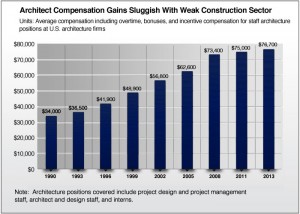
Architecture staff compensation tends to be more volatile over the business cycle than compensation for most other occupations. Over the past decade, compensation gains for architecture positions have more than kept pace with compensation across the entire economy. Architecture compensation increased 35 percent between early 2002 and early 2013, compared to just under 32 percent for all professional and related staff (typically defined as white-collar workers such as lawyers, accountants, etc.), and just over 29 percent for all private-sector workers (Exhibit 1.2).
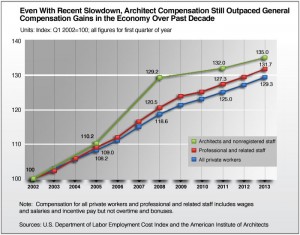
Compensation levels vary by firm size
Historically, large architecture firms have offered higher levels of compensation. These comparisons are more difficult for more senior positions because job responsibilities are difficult to compare across firms of different sizes. However, this disparity exists even for positions with relatively standard job descriptions such as Intern 1 or Architect 1.
At firms with fewer than 10 employees, Intern 1 compensation averaged 10 to 15 percent below national averages. At firms with more than 250 employees, Intern 1 compensation averaged more than 10 percent above the national average. A similar pattern held for Architect 1 positions: about 10 percent below the national average at firms with fewer than 10 employees, and almost 10 percent above the national average at firms with 250 or more employees.
Staff turnover and fringe benefits reflect improvement
Another sign that business conditions have stabilized across the profession is that benefits offered to employees have begun to modestly improve at many firms. While declining between 2008 and 2011 as firm revenues eroded, they rebounded modestly by 2013, with benefits packages averaging 18 percent of base salaries for professional staff. Benefits have bounced back faster at larger firms and remain significantly higher than those offered by smaller firms (Exhibit 1.3).
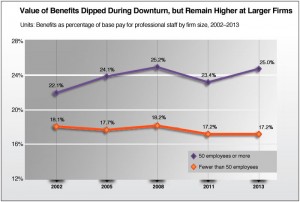
Recent Related:
AIA Compensation Survey: Architect Compensation Stagnant
Reference:
Purchase the 2013 AIA Compensation Report
New for 2013: Architect Compensation by Metro Area
Back to AIArchitect August 9, 2013
Go to the current issue of AIArchitect
Architecture Practice
|
aia, AIA NY, American Institute of Architects, architecture, Architecture billings index, Base Salaries, business, Compensation, economy, Great Recession, jobs, recession, Revenue, U.S. Census Bureau, unemployed architects
|

Now that summer is in full swing, all thoughts of cramming to finish overdue projects have likely drifted away. But just because you’ll be reading trashy magazines at the beach for the next month, doesn’t mean you can’t appreciate these stunning temples of learning. Designed by some of the world’s greatest architects, these 10 libraries will expand your mind even if you never pick up a book.
1. Philological “Brain” Library at the Free University — Berlin, Germany
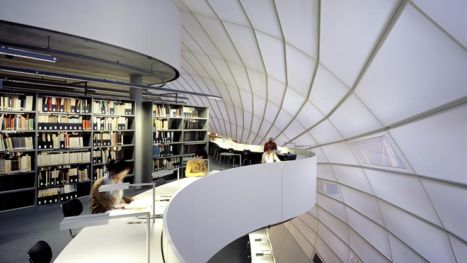
Designed by noted architect Norman Foster, a.k.a. Baron Foster of Thames Bank, this library on the campus of the Free University of Berlin, is in the shape of a human brain.
2. Phillips Exeter Academy Library – Exeter, New Hampshire

Phillips Exeter Academy Library was designed by renowned American architect Louis Kahn in 1965. Kahn structured the library in three concentric square rings, each one made from a different material, to give the visitor the sense that they are passing through buildings within buildings.
3. Cluain Mhuire Campus Library, Galway Mayo Institute of Technology — Galway, Ireland

Cluain Mhuire Campus Library was designed as a resource center for students and staff of GMIT who specialize in design, art, film and television. If this space doesn’t inspire them, it’s hard to imagine what will.
Continue reading for libraries 4-10

Featured Projects
We thought it would be really great to showcase our client’s projects to spread an inspirational vibe.
Therefore, we are giving you the opportunity to create a showcase of your project. Showcase your project with photos or hand sketches, and an optional blog post and video! Each month, CFA features one client project on our website, which receives over 600 hits per day AEC industry professionals. Featured clients include photographs and a blog post detailing the project.
To participate we ask for three high resolution project photographs with the dimensions of 215 wide x 135 high. We also ask you to choose one of the three photographs to be on the header of the blog post with the dimensions 950 wide x 430 high. Submit your project blog post on a Word document. The submission deadline is the Friday of the third week of the month. To participate, we require three high-resolution project photographs or hand-sketches (dimensions 215 wide x 135 high). We also ask you to choose one of the three photographs or a hand sketch to be on the header of your blog post (dimensions 950 wide x 430 high). To submit a video, please provide the URL link to your video.
Again, the submission deadline is the Friday of the third week of the month.
Thank you for your interest in showcasing your project on our website.
If you have any questions please contact David McFadden at (212) 532-4360 or [email protected]

Demand for architectural design fell in April to the lowest point of the year.
The Architecture Billings Index, which indicates construction volume, decreased marginally to 47.6 in April from 50.5 in March, according to American Institute of Architects data released Wednesday.
The benchmark for the index is 50. Anything above that indicates an increase in architectural billings and anything below indicates a decrease. The AIA surveys a panel of member firms monthly, asking if billings increased, decreased, or stayed the same. The national association then weighs the responses for the index.
April was the first month in 2011 the index swung below 50.
The sharp decline in demand for architectural services has analysts scratching their heads. Kermit Baker, chief economist at AIA, said he is unsure whether to attribute the drop to an industry-wide reversal in demand for design or a bump in the road.
“The fact that most construction projects funded under the federal stimulus program have completed their design work, the anxiety around the possibility of a shutdown in the federal government in April, as well as the unusually severe weather in the Southeast had something to do with this falloff,” Baker said. “However, the majority of firms are reporting at least one stalled project in-house because of the continued difficulty in obtaining financing.”
Baker also echoed Redwood Trust CEO Martin Hughes’ sentiment when he said financing continues to be the main roadblock to recovery. Hughes testified before the Senate Banking Committee Wednesday.
The new projects inquiry index also experienced a sharp drop in April, falling to 55 from 58.7 a month prior, according to AIA.
The regional buildings index was highest in the Northeast at 51.2, followed by the Midwest at 51.1, the South at 48.3, and the West at 47.7. The index was the highest in the multifamily residential sector (53.9) followed by the commercial/industrial sector (49.9), the institutional sector (45.9) and the mixed practice sector (45.2).
An exhibit at the American Institute of Architects headquarters shows off the LEED for Neighborhood Development rating system

The architecture firm Farr Associates, the Chicago Architecture Foundation, and the U.S. Green Building Council have produced a fantastic exhibit on how to create green neighborhoods. It opened in Chicago last year and is now on display at the American Institute of Architects headquarters in Washington.
This carries some symbolism. When it comes to sustainable communities, the architecture profession has been both hero and villain. It has been a hero because many of the early (and continuing) leaders of smart growth and sustainability in our built environment have been architects, from William McDonough to Peter Calthorpe, from Andres Duany to David Dixon. Frankly, in my opinion, architects were way ahead of the environmental community in forging solutions to sprawl. And it’s a good thing that they were, because they gave us environmentalists something positive to advocate.
Continue with article via The Atlantic
aia, architects, architecture, architecture critic, built environment, carbon-neutral office building, Design, eco building, Green Architecture, green buildings, Green Built Environment, Urban Planning
|
aia, American Institute of Architects, Andres Duany, Chicago Architecture Foundation, David Dixon, Farr Associates, LEED, Peter Calthorpe, sustainable communities, The Atlantic, U.S. Green Building Council, William McDonough
|
Our company began to experienc a slight uptick in hiring during May to present. This article by Prashant Gopal in Bloomberg Business seems to confirm what we are reporting:
May 19 (Bloomberg) — A leading indicator for U.S. commercial property construction showed signs of improvement in April, indicating a rebound in building may be near, the American Institute of Architects said.
The Architecture Billings Index climbed to 48.5 from 46.1 in March, the third straight monthly increase, the Washington- based group said today. While any score of less than 50 indicates a drop in demand from the previous month, April’s decline was the smallest since January 2008.
“It appears that the design and construction industry may be nearing an actual recovery phase,” Kermit Baker, the group’s chief economist, said in a statement. “The economic landscape is improving.”
The index is an indicator of future building of offices, warehouses, apartments and retail properties. There is typically a lag of about nine to 12 months between the time architects bill clients and when developers start spending on construction, according to the AIA.
Overall construction spending in the U.S. increased 0.2 percent in March, fueled by federal stimulus spending on power plants, hospitals and transportation projects, the Commerce Department said May 3. Private construction spending for non- residential projects fell 0.7 percent in March from the previous month and 26 percent from a year earlier.
Commercial Property Values
The Moody’s/REAL Commercial Property Price Index fell 0.5 percent from February, the second straight monthly decline, Moody’s said today in a report. Prices slid 25 percent from a year earlier and are down 42 percent from the peak reached in October 2007.
RNL, a Denver-based company that provides architectural work for mixed-use projects in the western U.S. and overseas, has added five employees over the past three months. It trimmed its workforce to about 150 from 250 during the past two years, said Richard von Luhrte, the firm’s president.
Foreign investors, public-private partnerships and landlords seeking to renovate distressed properties are driving von Luhrte’s business, he said in an interview.
“We’ve seen the bottom and we’re stable,” he said. “Obviously the last year has been challenging, but there are some opportunities out there.”
The Northeast was the strongest of the four regions measured by the American Institute of Architects index, registering 51 and showing growth in demand for commercial architects. It was followed by the Midwest at 49.2, the South at 46.5, and the West at 44.7.
The Architecture Billings Index is based on a survey of firms owned by AIA members. Participants are asked each month whether their billings increased, decreased or stayed the same.
aia, architect, architects, architecture, architecture jobs, Hiring trends, jobs, recession, unemployed architects
|
American Institute of Architects, Architecture billings index, Bloomberg, Commercial Property Values, Kermit Baker, Moody’s/REAL Commercial Property Price Index, Prashant Gopal
|

Very good article in THE HILL by George H. Miller, FAIA – 06/07/10 10:03 AM ET
When Congress returns this week, one of the first items on its agenda will be finding a way to pay for extending unemployment benefits to the millions of Americans who find themselves jobless even as the economy begins a slow and fitful recovery. The Senate hopes to begin work on the “tax extenders package” that was approved by the House of Representatives on May 28, just as lawmakers left for the Memorial Day Recess.
We sympathize with Congress as it looks for ways to pay for extending jobless benefits. Indeed, roughly 25 percent of my professional colleagues are unemployed – in some states the percentage is even higher – and would benefit from any extension, as well as from other provisions in the legislation, such as Build America Bonds. And yet, as world markets tremble from global debt anxiety, Congress is rightly pre-occupied with finding ways to fund the extension without adding to the ballooning deficit.
Bad decisions usually result when two such countervailing forces are at work. None is worse than the effort to help fund the extension by raising taxes on individuals and small businesses that form S Corporations. So-called S Corporations help to create jobs and economic growth by reinvesting hard-earned capital back into their enterprises. S-Corporation owners often pay themselves a salary, to which Social Security and Medicare taxes apply. But profits that are paid to the owner as a shareholder are not subject to payroll taxes. They will be for many S corporations, however, if this short-sighted provision passes and is signed into law by the President.
This type of tax hike comes at a time when many people – out of necessity due to layoffs and restructurings throughout the economy – are forming their own home-based consultancies, web design firms, landscaping enterprises and the like. If they structure themselves as an S Corporation – and many of them do – they would be caught up in this new tax just as they are planning to set up shop, hire staffers and buy the equipment they need to get started.
That is certainly the case in the architecture profession. We are struggling to find ways to restructure and resuscitate our careers and livelihoods after the collapse of the real estate market. Many of us operate as S Corporations, because it allows us the flexibility to compete in world markets and retain and attract the talent that has kept American architecture the envy of the world. We may be forced to lay off staff or stop hiring new staff to pay the new tax – even though this provision is in a “jobs” bill. The provision is particularly troubling in that it specifically calls out S corporations with three or fewer key employees.
We applaud Congress’s effort to find a way to extend unemployment benefits for individuals who need them. But as the economy begins to recover, now is the worst time to raise taxes on a sector that is a catalyst for job growth in the design and construction industry. After 27 consecutive months of contracting, the American Institute of Architects in May reported that architectural billings have trended upward for the third consecutive month. That’s an indication that new construction could be on the rise in nine to 12 months, which would create more jobs and advance our nation’s economic recovery.
Rather than hike taxes, Congress should enact legislation that generates revenue with little or no cost to the Treasury. One such bill is H.R. 5249, the Capital Access for Main Street Act of 2010, introduced by Reps. Ed Perlmutter (D-CO) and Mike Coffman (R-CO). This legislation would change accounting rules for community banks with less than $10 billion in assets as they work with borrowers to renegotiate loan terms, avoid large sums of commercial foreclosures, and free up credit that can be used more constructively.
Unscrupulous businesses do use S corporation status to avoid paying their proper share of taxes and they should be caught and punished. But the Internal Revenue Service is already empowered to address that issue. This tax hike lumps together the good and the bad, penalizing thousands of honest small businesses that follow the rules. We strongly urge Congress not to support this inappropriate tax increase.
George H. Miller is president of the American Institute of Architects, based in Washington, D.C.
aia, architect, architects, architecture, architecture jobs, Hiring trends, recession, unemployed architects
|
aia, American Institute of Architects, architecture profession, Congress, design and construction industry, FAIA, George H. Miller, H.R. 5249, House of Representatives, Mike Coffman (R-CO), Real Estate, Reps. Ed Perlmutter (D-CO), S Corporations, Senate, Tax, tax increase, The Hill, unemployed architects
|
























